rims MERCEDES-BENZ CLS 2010 Owners Manual
[x] Cancel search | Manufacturer: MERCEDES-BENZ, Model Year: 2010, Model line: CLS, Model: MERCEDES-BENZ CLS 2010Pages: 308, PDF Size: 5.71 MB
Page 16 of 308
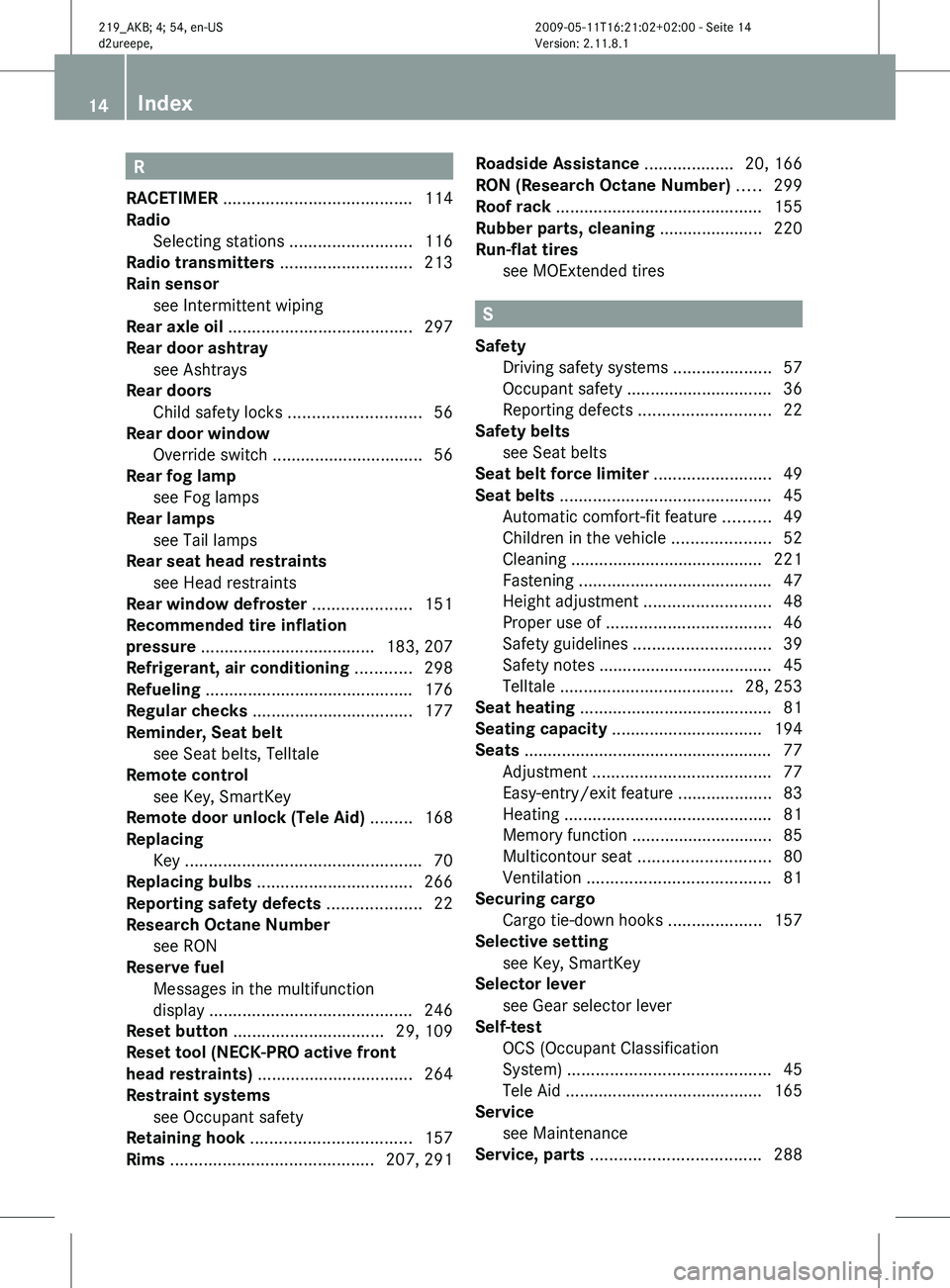
R
RACETIMER ........................................ 114
Radio Selecting stations
..........................116
Radio transmitters ............................213
Rain sensor see Intermittent wiping
Rear axle oil ....................................... 297
Rear door ashtray see Ashtrays
Rear doors
Child safety locks ............................ 56
Rear door window
Override switch ................................ 56
Rear fog lamp
see Fog lamps
Rear lamps
see Tail lamps
Rear seat head restraints
see Head restraints
Rear window defroster ..................... 151
Recommended tire inflation
pressure ..................................... 183, 207
Refrigerant, air conditioning ............ 298
Refueling ............................................ 176
Regular checks .................................. 177
Reminder, Seat belt see Seat belts, Telltale
Remote control
see Key, SmartKey
Remote door unlock (Tele Aid) .........168
Replacing
Key .................................................. 70
Replacing bulbs ................................. 266
Reporting safety defects .................... 22
Research Octane Number see RON
Reserve fuel
Messages in the multifunction
display ........................................... 246
Reset button ................................ 29, 109
Reset tool (NECK-PRO active front
head restraints) ................................. 264
Restraint systems see Occupant safety
Retaining hook .................................. 157
Rims ........................................... 207, 291Roadside Assistance
...................20, 166
RON (Research Octane Number) ..... 299
Roof rack ............................................ 155
Rubber parts, cleaning ......................
220
Run-flat tires see MOExtended tires S
Safety Driving safety systems ..................... 57
Occupant safety ...............................
36
Reporting defects ............................ 22
Safety belts
see Seat belts
Seat belt force limiter ......................... 49
Seat belts ............................................. 45
Automatic comfort-fit feature .......... 49
Children in the vehicle .....................52
Cleaning ......................................... 221
Fastening ......................................... 47
Height adjustment ...........................48
Proper use of ................................... 46
Safety guidelines ............................. 39
Safety notes ..................................... 45
Telltale ..................................... 28, 253
Seat heating ......................................... 81
Seating capacity ................................ 194
Seats ..................................................... 77 Adjustment ...................................... 77
Easy-entry/exit feature ....................83
Heating ............................................ 81
Memory function .............................. 85
Multicontour seat ............................ 80
Ventilation ....................................... 81
Securing cargo
Cargo tie-down hooks .................... 157
Selective setting
see Key, SmartKey
Selector lever
see Gear selector lever
Self-test
OCS (Occupant Classification
System) ........................................... 45
Tele Aid .......................................... 165
Service
see Maintenance
Service, parts .................................... 28814
Index 219_AKB; 4; 54, en-US
d2ureepe,
Version: 2.11.8.1 2009-05-11T16:21:02+02:00 - Seite 14
Page 17 of 308
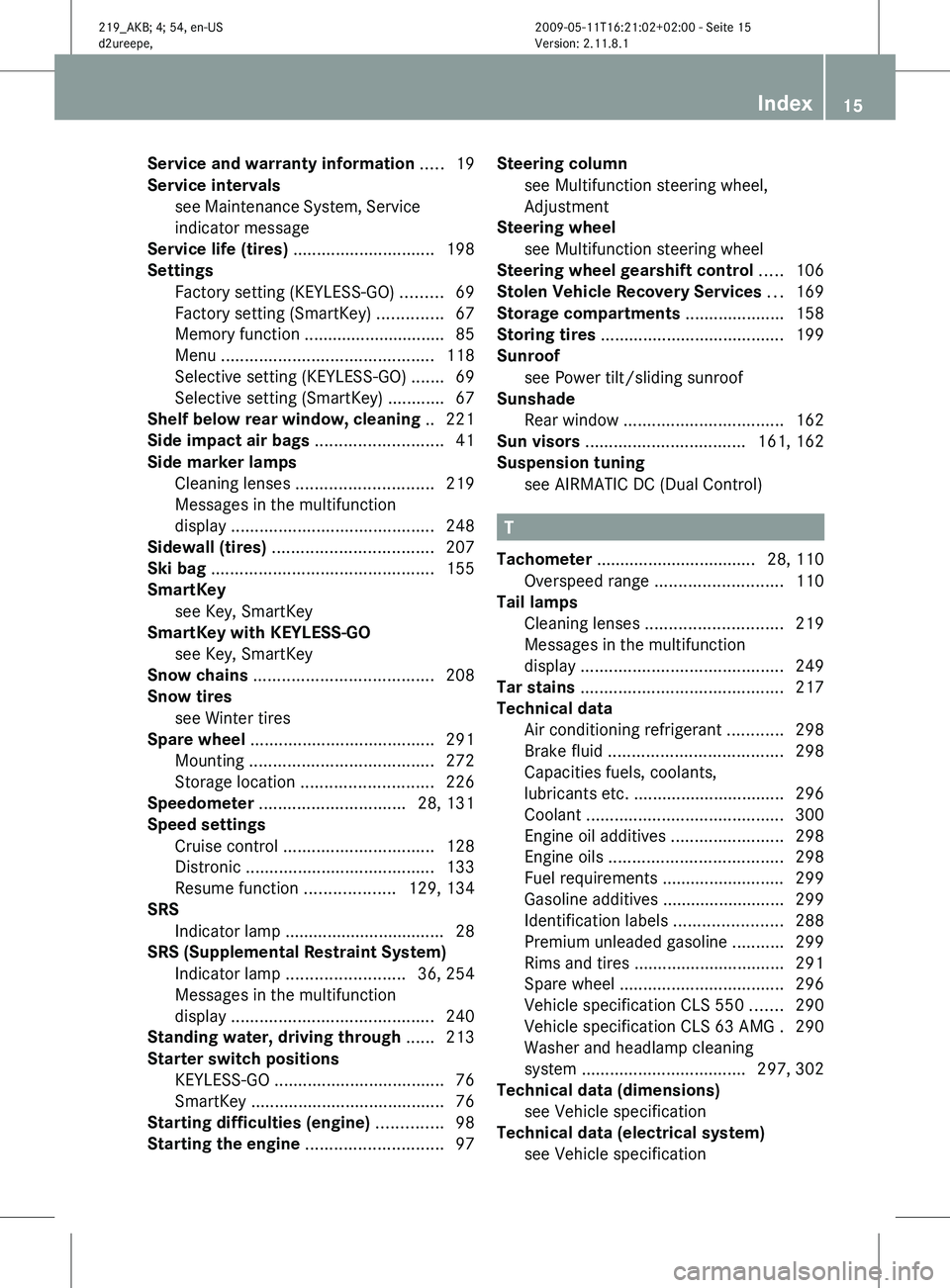
Service and warranty information
.....19
Service intervals see
Maintenance System, Service
indicator message
Service life (tires) .............................. 198
Settings Factory setting (KEYLESS-GO) ......... 69
Factory setting (SmartKey) ..............67
Memory function .............................. 85
Menu ............................................. 118
Selective setting (KEYLESS-GO) ....... 69
Selective setting (SmartKey) ............67
Shelf below rear window, cleaning .. 221
Side impact air bags ...........................41
Side marker lamps
Cleaning lenses ............................. 219
Messages in the multifunction
display ........................................... 248
Sidewall (tires) .................................. 207
Ski bag ............................................... 155
SmartKey see Key, SmartKey
SmartKey with KEYLESS-GO
see Key, SmartKey
Snow chains ...................................... 208
Snow tires see Winter tires
Spare wheel ....................................... 291
Mounting ....................................... 272
Storage location ............................ 226
Speedometer ............................... 28, 131
Speed settings Cruise control ................................ 128
Distronic ........................................ 133
Resume function ................... 129, 134
SRS
Indicator lamp .................................. 28
SRS (Supplemental Restraint System)
Indicator lamp ......................... 36, 254
Messages in the multifunction
display ........................................... 240
Standing water, driving through ......213
Starter switch positions KEYLESS-GO .................................... 76
SmartKey ......................................... 76
Starting difficulties (engine) ..............98
Starting the engine ............................. 97Steering column
see Multifunction steering wheel,
Adjustment
Steering wheel
see Multifunction steering wheel
Steering wheel gearshift control .....106
Stolen Vehicle Recovery Services ...169
Storage compartments .....................158
Storing tires ....................................... 199
Sunroof see Power tilt/sliding sunroof
Sunshade
Rear window .................................. 162
Sun visors .................................. 161, 162
Suspension tuning see AIRMATIC DC (Dual Control) T
Tachometer ..................................
28, 110
Overspeed range ........................... 110
Tail lamps
Cleaning lenses ............................. 219
Messages in the multifunction
display ........................................... 249
Tar stains ........................................... 217
Technical data Air conditioning refrigerant ............ 298
Brake fluid ..................................... 298
Capacities fuels, coolants,
lubricants etc. ................................ 296
Coolant .......................................... 300
Engine oil additives ........................298
Engine oils ..................................... 298
Fuel requirements .......................... 299
Gasoline additives .......................... 299
Identification labels .......................288
Premium unleaded gasoline ...........299
Rims and tires ................................ 291
Spare wheel ................................... 296
Vehicle specification CLS 550 ....... 290
Vehicle specification CLS 63 AMG . 290
Washer and headlamp cleaning
system ................................... 297, 302
Technical data (dimensions)
see Vehicle specification
Technical data (electrical system)
see Vehicle specification Index
15 219_AKB; 4; 54, en-US
d2ureepe,
Version: 2.11.8.1 2009-05-11T16:21:02+02:00 - Seite 15
Page 18 of 308
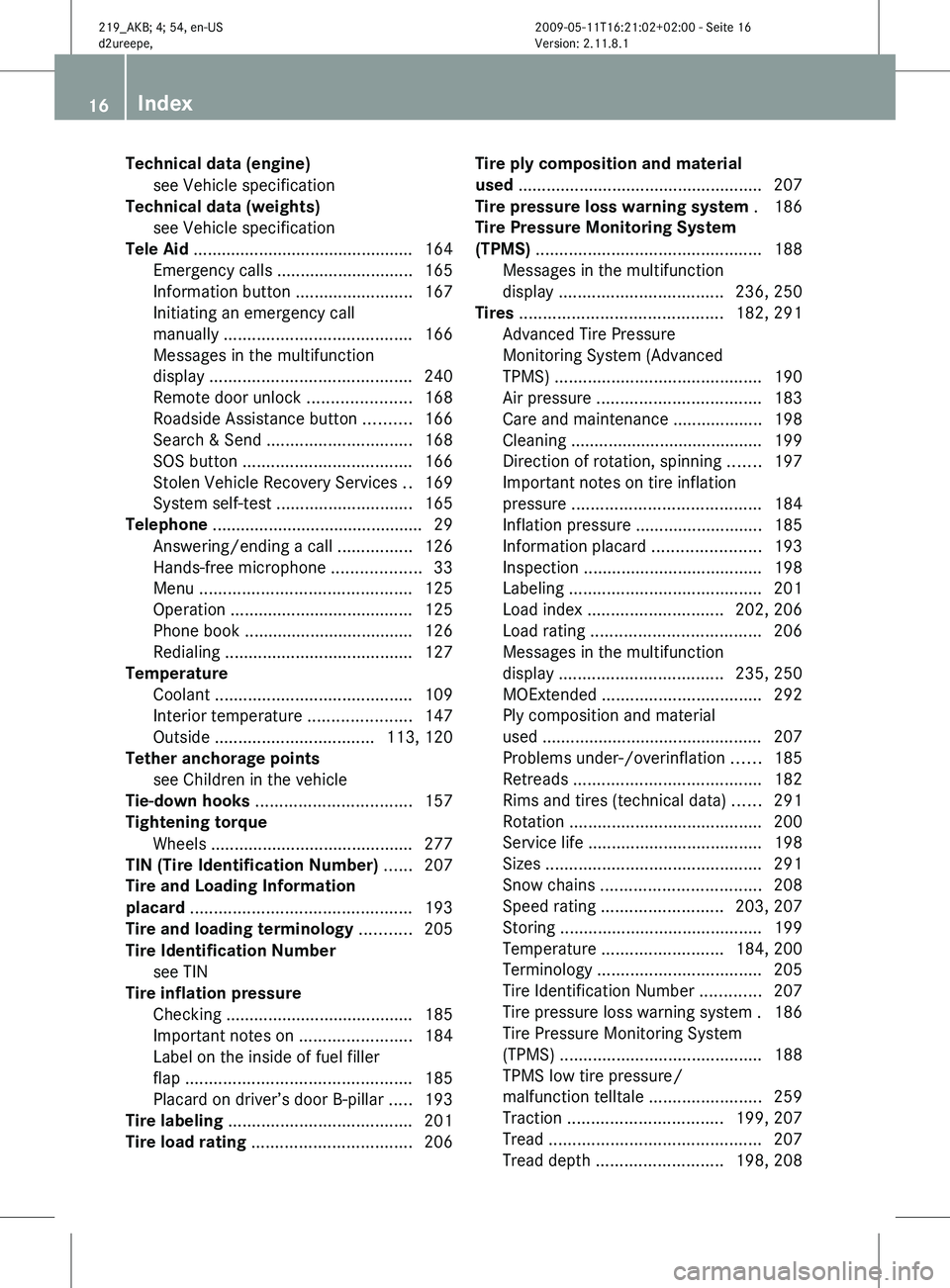
Technical data (engine)
see Vehicle specification
Technical data (weights)
see Vehicle specification
Tele Aid ............................................... 164
Emergency calls ............................. 165
Information button .........................167
Initiating an emergency call
manually ........................................ 166
Messages in the multifunction
display ........................................... 240
Remote door unlock ...................... 168
Roadside Assistance button .......... 166
Search & Send ............................... 168
SOS button .................................... 166
Stolen Vehicle Recovery Services .. 169
System self-test ............................. 165
Telephone ............................................. 29
Answering/ending a call ................ 126
Hands-free microphone ...................33
Menu ............................................. 125
Operation ....................................... 125
Phone book .................................... 126
Redialing ........................................ 127
Temperature
Coolant .......................................... 109
Interior temperature ......................147
Outside .................................. 113, 120
Tether anchorage points
see Children in the vehicle
Tie-down hooks ................................. 157
Tightening torque Wheels ........................................... 277
TIN (Tire Identification Number) ...... 207
Tire and Loading Information
placard ............................................... 193
Tire and loading terminology ...........205
Tire Identification Number see TIN
Tire inflation pressure
Checking ........................................ 185
Important notes on ........................ 184
Label on the inside of fuel filler
flap ................................................ 185
Placard on driver’s door B-pillar ..... 193
Tire labeling ....................................... 201
Tire load rating .................................. 206Tire ply composition and material
used ....................................................
207
Tire pressure loss warning system .
186
Tire Pressure Monitoring System
(TPMS) ................................................ 188
Messages in the multifunction
display ................................... 236, 250
Tires ........................................... 182, 291
Advanced Tire Pressure
Monitoring System (Advanced
TPMS) ............................................ 190
Air pressure ................................... 183
Care and maintenance ................... 198
Cleaning ......................................... 199
Direction of rotation, spinning .......197
Important notes on tire inflation
pressure ........................................ 184
Inflation pressure ........................... 185
Information placard ....................... 193
Inspection ...................................... 198
Labeling ......................................... 201
Load index ............................. 202, 206
Load rating .................................... 206
Messages in the multifunction
display ................................... 235, 250
MOExtended .................................. 292
Ply composition and material
used ............................................... 207
Problems under-/overinflation ...... 185
Retreads ........................................ 182
Rims and tires (technical data) ...... 291
Rotation ......................................... 200
Service life ..................................... 198
Sizes .............................................. 291
Snow chains .................................. 208
Speed rating .......................... 203, 207
Storing ........................................... 199
Temperature .......................... 184, 200
Terminology ................................... 205
Tire Identification Number ............. 207
Tire pressure loss warning system . 186
Tire Pressure Monitoring System
(TPMS) ........................................... 188
TPMS low tire pressure/
malfunction telltale ........................ 259
Traction ................................. 199, 207
Tread ............................................. 207
Tread depth ........................... 198, 20816
Index 219_AKB; 4; 54, en-US
d2ureepe,
Version: 2.11.8.1 2009-05-11T16:21:02+02:00 - Seite 16
Page 20 of 308
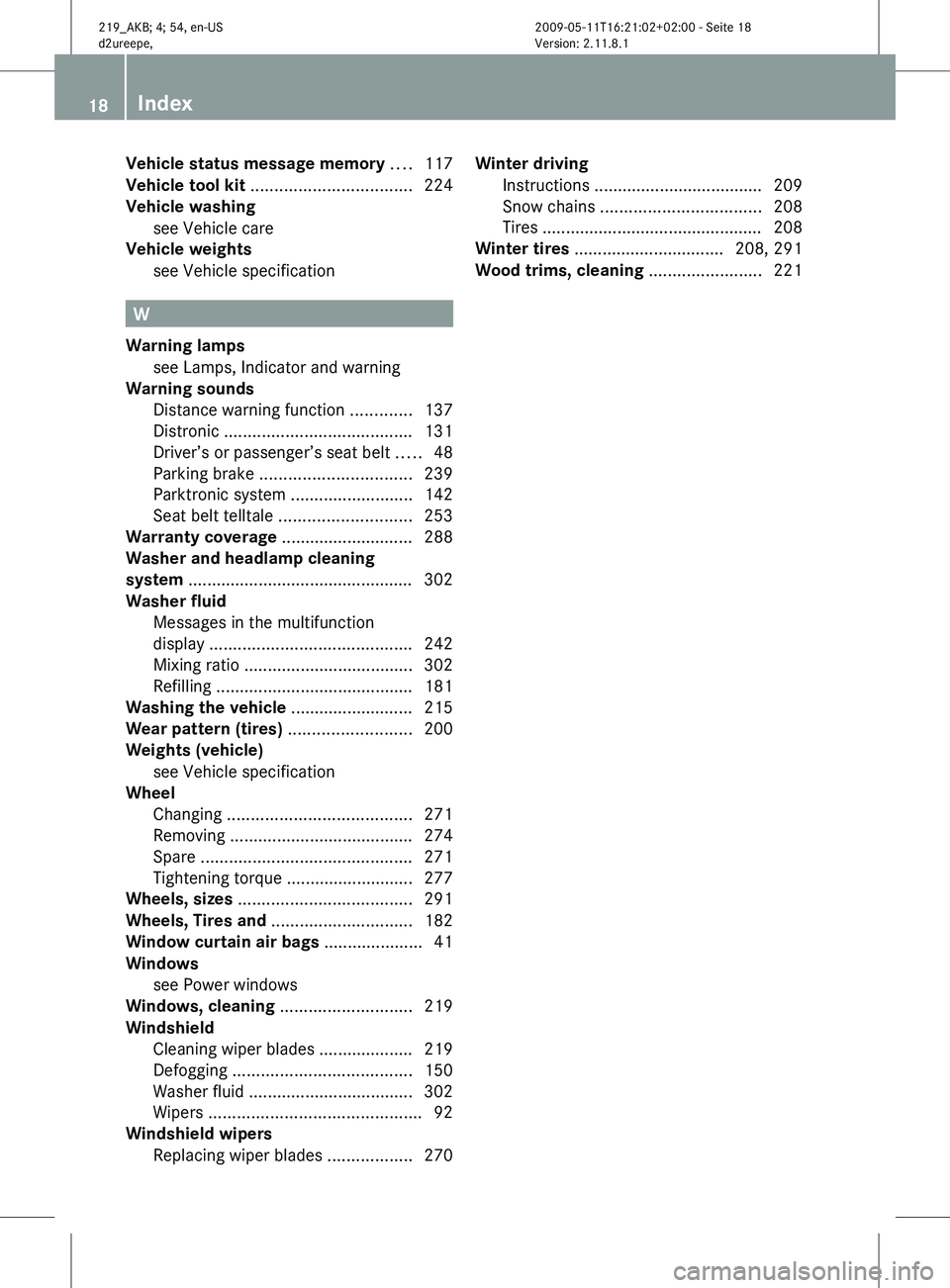
Vehicle status message memory ....
117
Vehicle tool kit .................................. 224
Vehicle washing see Vehicle care
Vehicle weights
see Vehicle specification W
Warning lamps see Lamps, Indicator and warning
Warning sounds
Distance warning function .............137
Distronic ........................................ 131
Driver’s or passenger’s seat belt ..... 48
Parking brake ................................ 239
Parktronic system ..........................142
Seat belt telltale ............................ 253
Warranty coverage ............................ 288
Washer and headlamp cleaning
system ................................................ 302
Washer fluid
Messages in the multifunction
display ........................................... 242
Mixing ratio .................................... 302
Refilling .......................................... 181
Washing the vehicle .......................... 215
Wear pattern (tires) ..........................200
Weights (vehicle) see Vehicle specification
Wheel
Changing ....................................... 271
Removing ....................................... 274
Spare ............................................. 271
Tightening torque ........................... 277
Wheels, sizes ..................................... 291
Wheels, Tires and .............................. 182
Window curtain air bags ..................... 41
Windows see Power windows
Windows, cleaning ............................219
Windshield Cleaning wiper blades .................... 219
Defogging ...................................... 150
Washer fluid ................................... 302
Wipers ............................................. 92
Windshield wipers
Replacing wiper blades .................. 270Winter driving
Instructions
.................................... 209
Snow chains .................................. 208
Tires ............................................... 208
Winter tires ................................ 208, 291
Wood trims, cleaning ........................ 22118
Index 219_AKB; 4; 54, en-US
d2ureepe,
Version: 2.11.8.1 2009-05-11T16:21:02+02:00 - Seite 18
Page 28 of 308
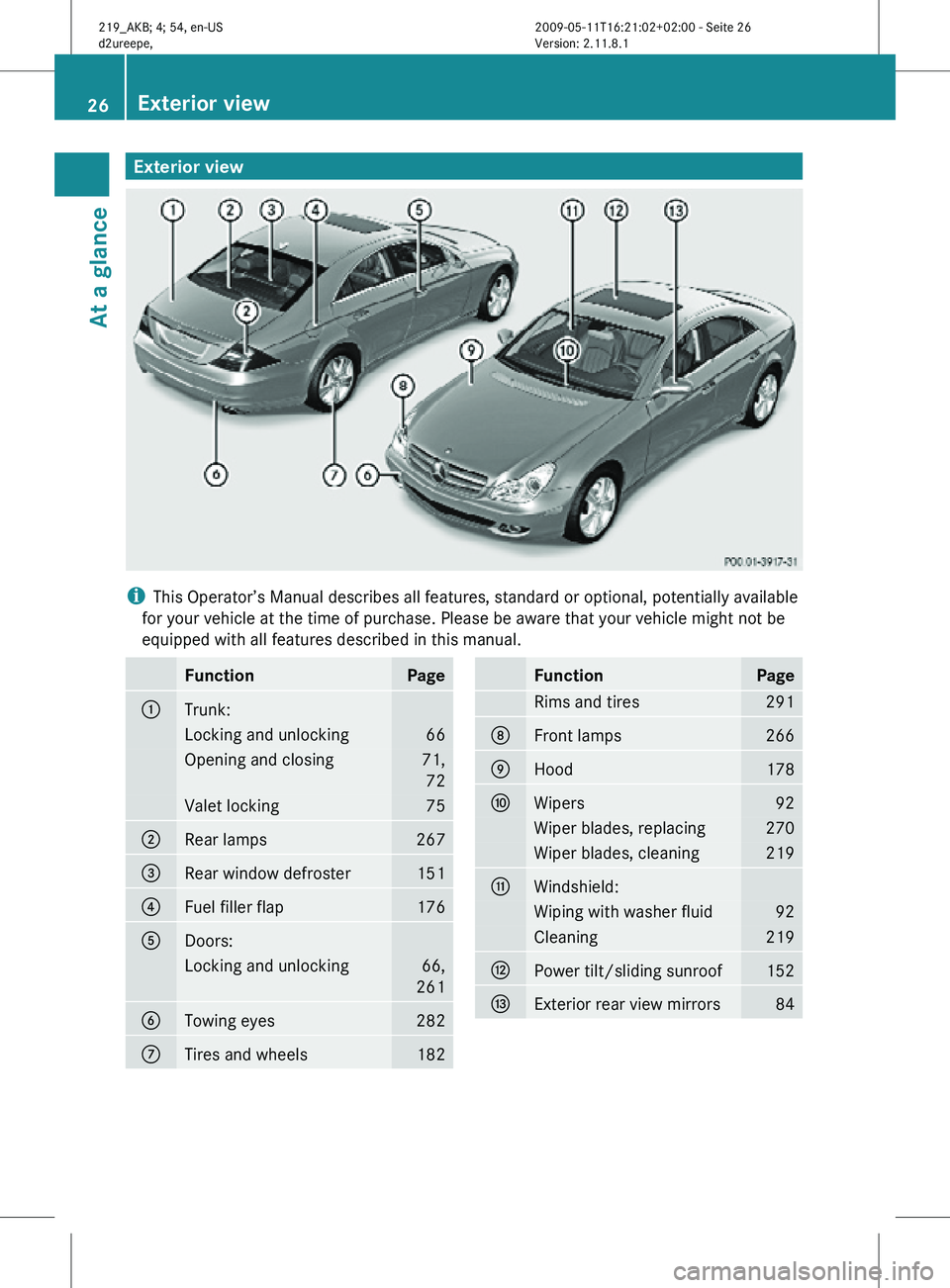
Exterior view
i
This Operator’s Manual describes all features, standard or optional, potentially available
for your vehicle at the time of purchase. Please be aware that your vehicle might not be
equipped with all features described in this manual. Function Page
:
Trunk:
Locking and unlocking 66
Opening and closing 71,
72 Valet locking 75
;
Rear lamps 267
=
Rear window defroster 151
?
Fuel filler flap 176
A
Doors:
Locking and unlocking 66,
261 B
Towing eyes 282
C
Tires and wheels 182 Function Page
Rims and tires 291
D
Front lamps 266
E
Hood 178
F
Wipers 92
Wiper blades, replacing 270
Wiper blades, cleaning 219
G
Windshield:
Wiping with washer fluid 92
Cleaning 219
H
Power tilt/sliding sunroof 152
I
Exterior rear view mirrors 8426
Exterior viewAt a glance
219_AKB; 4; 54, en-US
d2ureepe,
Version: 2.11.8.1 2009-05-11T16:21:02+02:00 - Seite 26
Page 41 of 308
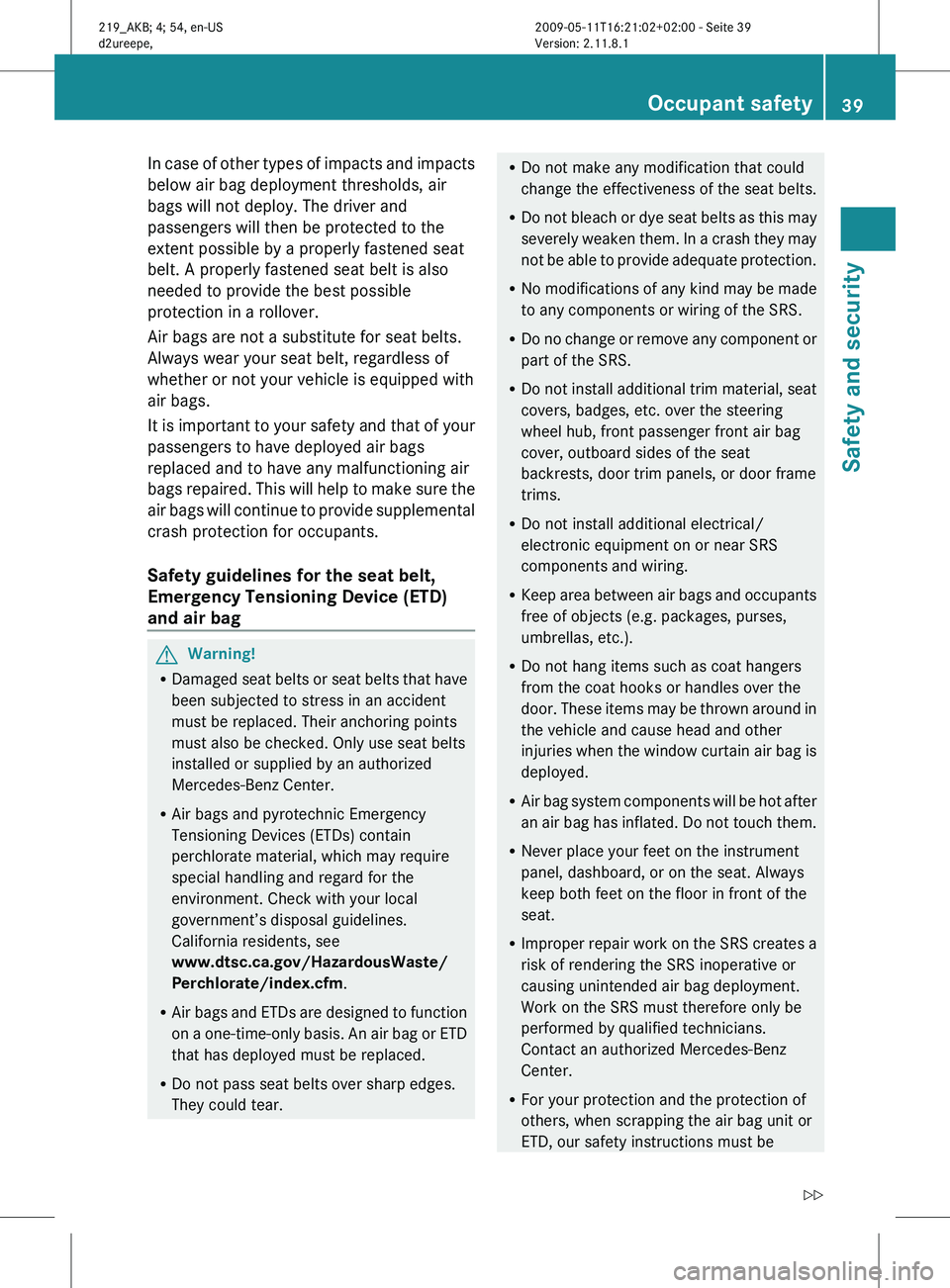
In case of other types of impacts and impacts
below air bag deployment thresholds, air
bags will not deploy. The driver and
passengers will then be protected to the
extent possible by a properly fastened seat
belt. A properly fastened seat belt is also
needed to provide the best possible
protection in a rollover.
Air bags are not a substitute for seat belts.
Always wear your seat belt, regardless of
whether or not your vehicle is equipped with
air bags.
It
is important to your safety and that of your
passengers to have deployed air bags
replaced and to have any malfunctioning air
bags repaired. This will help to make sure the
air bags will continue to provide supplemental
crash protection for occupants.
Safety guidelines for the seat belt,
Emergency Tensioning Device (ETD)
and air bag G
Warning!
R Damaged
seat belts or seat belts that have
been subjected to stress in an accident
must be replaced. Their anchoring points
must also be checked. Only use seat belts
installed or supplied by an authorized
Mercedes-Benz Center.
R Air bags and pyrotechnic Emergency
Tensioning Devices (ETDs) contain
perchlorate material, which may require
special handling and regard for the
environment. Check with your local
government’s disposal guidelines.
California residents, see
www.dtsc.ca.gov/HazardousWaste/
Perchlorate/index.cfm.
R Air bags and ETDs are designed to function
on a one-time-only basis. An air bag or ETD
that has deployed must be replaced.
R Do not pass seat belts over sharp edges.
They could tear. R
Do not make any modification that could
change the effectiveness of the seat belts.
R Do
not bleach or dye seat belts as this may
severely weaken them. In a crash they may
not be able to provide adequate protection.
R No modifications of any kind may be made
to any components or wiring of the SRS.
R Do no change or remove any component or
part of the SRS.
R Do not install additional trim material, seat
covers, badges, etc. over the steering
wheel hub, front passenger front air bag
cover, outboard sides of the seat
backrests, door trim panels, or door frame
trims.
R Do not install additional electrical/
electronic equipment on or near SRS
components and wiring.
R Keep area between air bags and occupants
free of objects (e.g. packages, purses,
umbrellas, etc.).
R Do not hang items such as coat hangers
from the coat hooks or handles over the
door. These items may be thrown around in
the vehicle and cause head and other
injuries when the window curtain air bag is
deployed.
R Air bag system components will be hot after
an air bag has inflated. Do not touch them.
R Never place your feet on the instrument
panel, dashboard, or on the seat. Always
keep both feet on the floor in front of the
seat.
R Improper repair work on the SRS creates a
risk of rendering the SRS inoperative or
causing unintended air bag deployment.
Work on the SRS must therefore only be
performed by qualified technicians.
Contact an authorized Mercedes-Benz
Center.
R For your protection and the protection of
others, when scrapping the air bag unit or
ETD, our safety instructions must be Occupant safety
39
Safety and security
219_AKB; 4; 54, en-US
d2ureepe, Version: 2.11.8.1 2009-05-11T16:21:02+02:00 - Seite 39 Z
Page 184 of 308
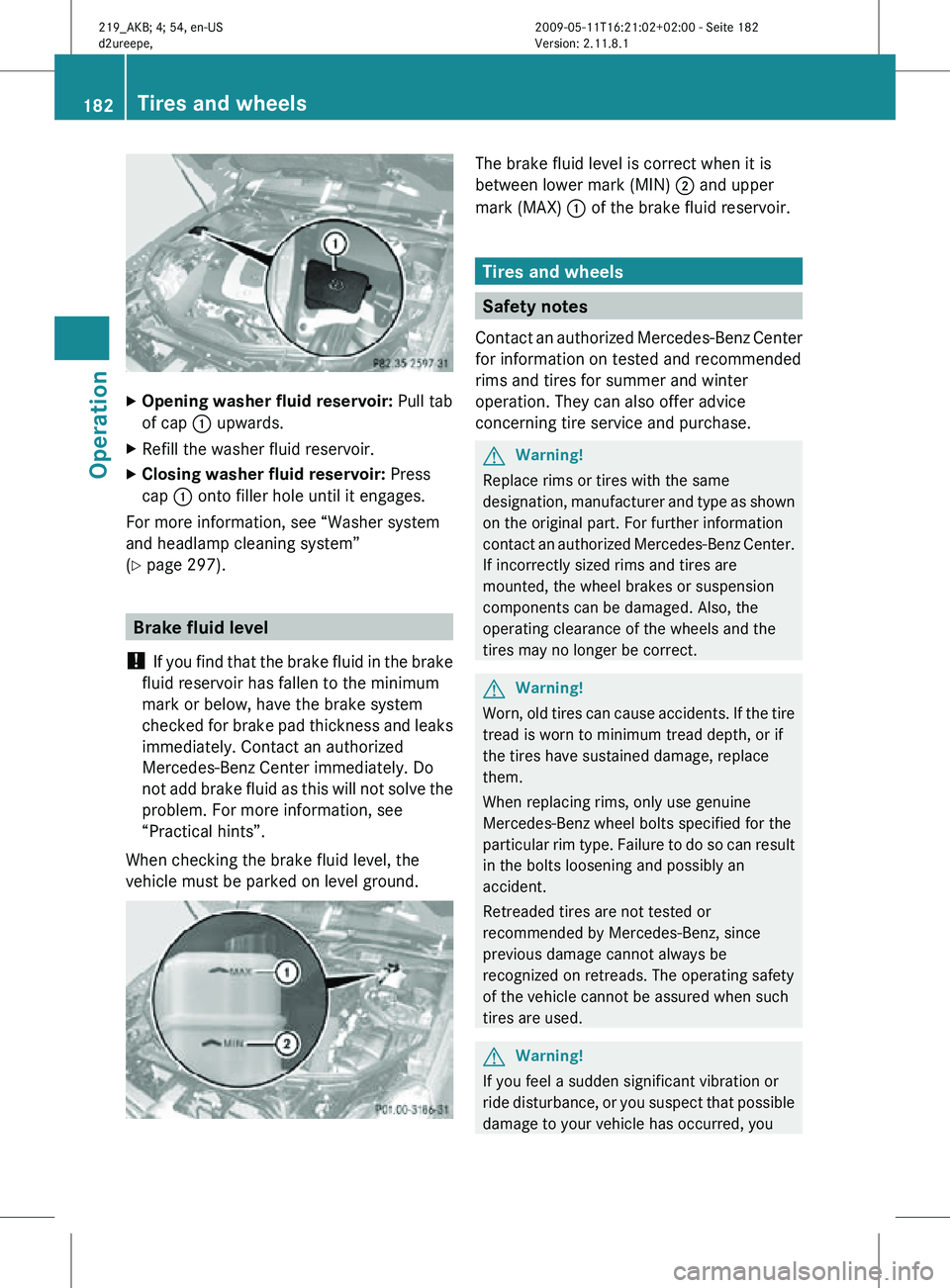
X
Opening washer fluid reservoir: Pull tab
of cap : upwards.
X Refill the washer fluid reservoir.
X Closing washer fluid reservoir: Press
cap : onto filler hole until it engages.
For more information, see “Washer system
and headlamp cleaning system”
(Y page 297). Brake fluid level
! If you find that the brake fluid in the brake
fluid reservoir has fallen to the minimum
mark or below, have the brake system
checked for brake pad thickness and leaks
immediately. Contact an authorized
Mercedes-Benz Center immediately. Do
not add brake fluid as this will not solve the
problem. For more information, see
“Practical hints”.
When checking the brake fluid level, the
vehicle must be parked on level ground. The brake fluid level is correct when it is
between lower mark (MIN)
; and upper
mark (MAX) : of the brake fluid reservoir. Tires and wheels
Safety notes
Contact an authorized Mercedes-Benz Center
for information on tested and recommended
rims and tires for summer and winter
operation. They can also offer advice
concerning tire service and purchase. G
Warning!
Replace rims or tires with the same
designation, manufacturer and type as shown
on the original part. For further information
contact an authorized Mercedes-Benz Center.
If incorrectly sized rims and tires are
mounted, the wheel brakes or suspension
components can be damaged. Also, the
operating clearance of the wheels and the
tires may no longer be correct. G
Warning!
Worn, old tires can cause accidents. If the tire
tread is worn to minimum tread depth, or if
the tires have sustained damage, replace
them.
When replacing rims, only use genuine
Mercedes-Benz wheel bolts specified for the
particular rim type. Failure to do so can result
in the bolts loosening and possibly an
accident.
Retreaded tires are not tested or
recommended by Mercedes-Benz, since
previous damage cannot always be
recognized on retreads. The operating safety
of the vehicle cannot be assured when such
tires are used. G
Warning!
If you feel a sudden significant vibration or
ride disturbance, or you suspect that possible
damage to your vehicle has occurred, you 182
Tires and wheelsOperation
219_AKB; 4; 54, en-US
d2ureepe,
Version: 2.11.8.1 2009-05-11T16:21:02+02:00 - Seite 182
Page 185 of 308
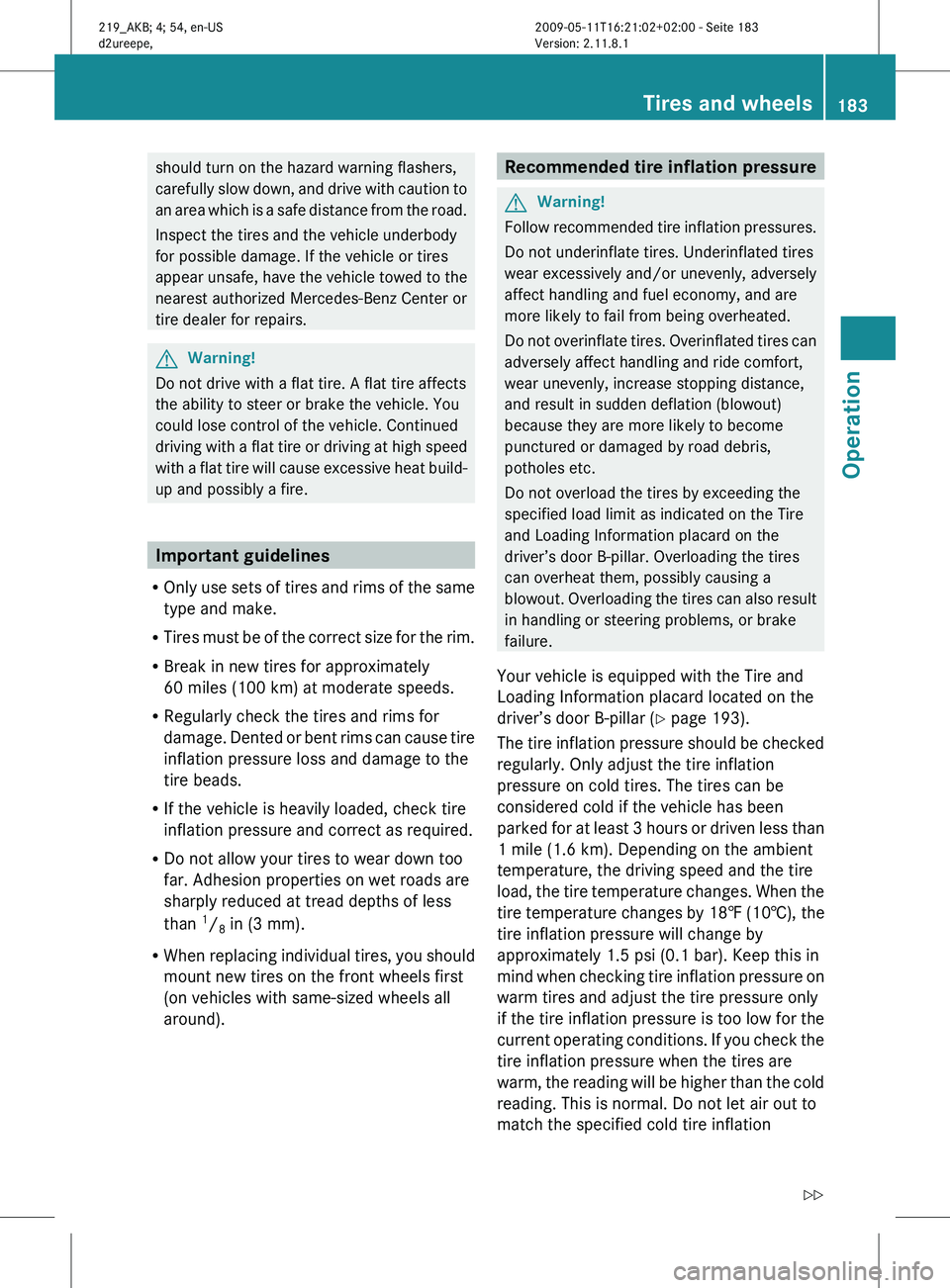
should turn on the hazard warning flashers,
carefully
slow down, and drive with caution to
an area which is a safe distance from the road.
Inspect the tires and the vehicle underbody
for possible damage. If the vehicle or tires
appear unsafe, have the vehicle towed to the
nearest authorized Mercedes-Benz Center or
tire dealer for repairs. G
Warning!
Do not drive with a flat tire. A flat tire affects
the ability to steer or brake the vehicle. You
could lose control of the vehicle. Continued
driving
with a flat tire or driving at high speed
with a flat tire will cause excessive heat build-
up and possibly a fire. Important guidelines
R Only
use sets of tires and rims of the same
type and make.
R Tires must be of the correct size for the rim.
R Break in new tires for approximately
60 miles (100 km) at moderate speeds.
R Regularly check the tires and rims for
damage. Dented or bent rims can cause tire
inflation pressure loss and damage to the
tire beads.
R If the vehicle is heavily loaded, check tire
inflation pressure and correct as required.
R Do not allow your tires to wear down too
far. Adhesion properties on wet roads are
sharply reduced at tread depths of less
than 1
/ 8 in (3 mm).
R When replacing individual tires, you should
mount new tires on the front wheels first
(on vehicles with same-sized wheels all
around). Recommended tire inflation pressure
G
Warning!
Follow recommended tire inflation pressures.
Do not underinflate tires. Underinflated tires
wear excessively and/or unevenly, adversely
affect handling and fuel economy, and are
more likely to fail from being overheated.
Do
not overinflate tires. Overinflated tires can
adversely affect handling and ride comfort,
wear unevenly, increase stopping distance,
and result in sudden deflation (blowout)
because they are more likely to become
punctured or damaged by road debris,
potholes etc.
Do not overload the tires by exceeding the
specified load limit as indicated on the Tire
and Loading Information placard on the
driver’s door B-pillar. Overloading the tires
can overheat them, possibly causing a
blowout. Overloading the tires can also result
in handling or steering problems, or brake
failure.
Your vehicle is equipped with the Tire and
Loading Information placard located on the
driver’s door B-pillar ( Y page 193).
The tire inflation pressure should be checked
regularly. Only adjust the tire inflation
pressure on cold tires. The tires can be
considered cold if the vehicle has been
parked for at least 3 hours or driven less than
1 mile (1.6 km). Depending on the ambient
temperature, the driving speed and the tire
load, the tire temperature changes. When the
tire temperature changes by 18‡ (10†), the
tire inflation pressure will change by
approximately 1.5 psi (0.1 bar). Keep this in
mind when checking tire inflation pressure on
warm tires and adjust the tire pressure only
if the tire inflation pressure is too low for the
current operating conditions. If you check the
tire inflation pressure when the tires are
warm, the reading will be higher than the cold
reading. This is normal. Do not let air out to
match the specified cold tire inflation Tires and wheels
183
Operation
219_AKB; 4; 54, en-US
d2ureepe, Version: 2.11.8.1 2009-05-11T16:21:02+02:00 - Seite 183 Z
Page 202 of 308
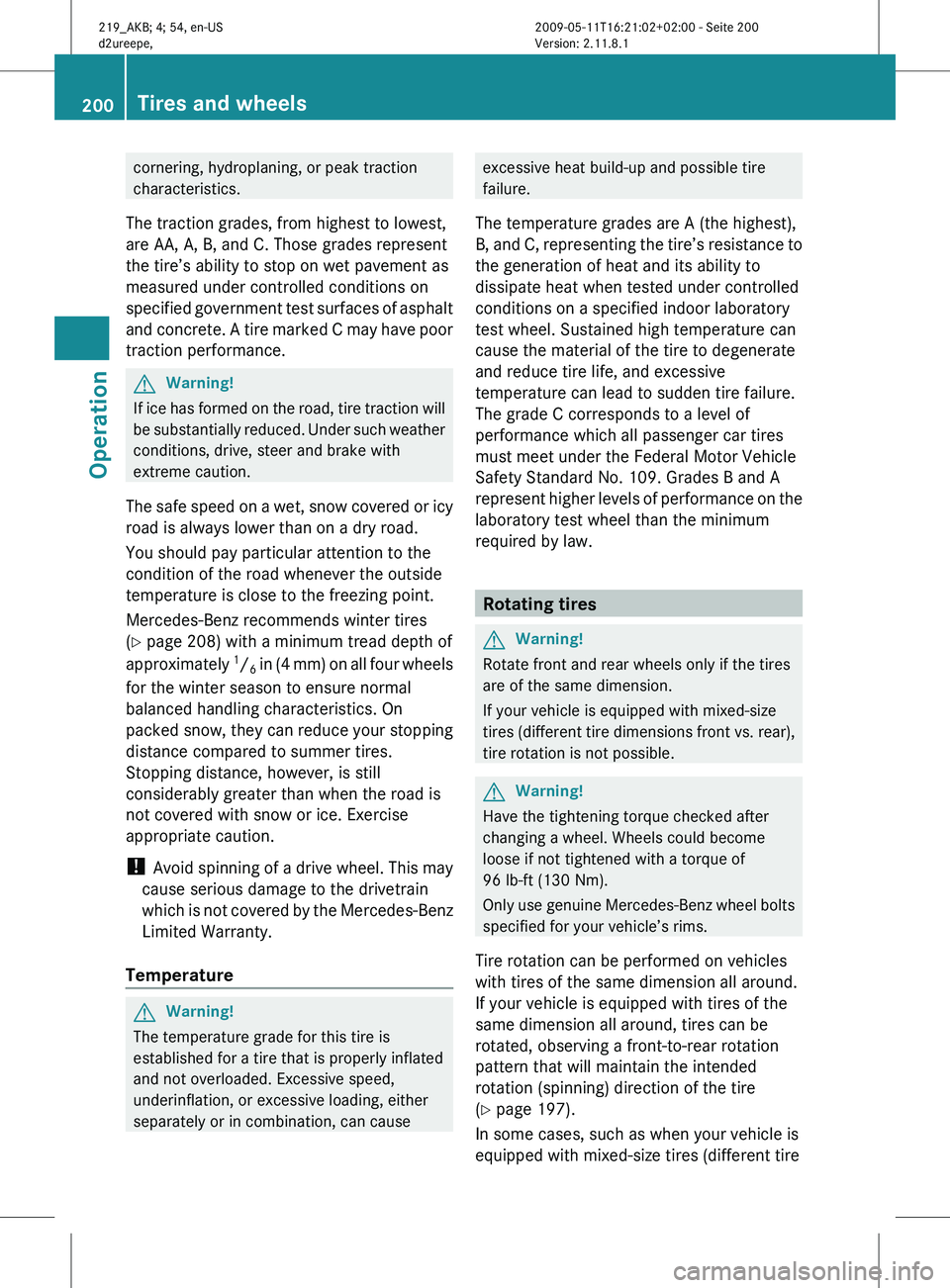
cornering, hydroplaning, or peak traction
characteristics.
The traction grades, from highest to lowest,
are AA, A, B, and C. Those grades represent
the tire’s ability to stop on wet pavement as
measured under controlled conditions on
specified
government test surfaces of asphalt
and concrete. A tire marked C may have poor
traction performance. G
Warning!
If ice has formed on the road, tire traction will
be
substantially reduced. Under such weather
conditions, drive, steer and brake with
extreme caution.
The safe speed on a wet, snow covered or icy
road is always lower than on a dry road.
You should pay particular attention to the
condition of the road whenever the outside
temperature is close to the freezing point.
Mercedes-Benz recommends winter tires
(Y page 208) with a minimum tread depth of
approximately 1
/ 6 in (4 mm) on all four wheels
for the winter season to ensure normal
balanced handling characteristics. On
packed snow, they can reduce your stopping
distance compared to summer tires.
Stopping distance, however, is still
considerably greater than when the road is
not covered with snow or ice. Exercise
appropriate caution.
! Avoid spinning of a drive wheel. This may
cause serious damage to the drivetrain
which is not covered by the Mercedes-Benz
Limited Warranty.
Temperature G
Warning!
The temperature grade for this tire is
established for a tire that is properly inflated
and not overloaded. Excessive speed,
underinflation, or excessive loading, either
separately or in combination, can cause excessive heat build-up and possible tire
failure.
The temperature grades are A (the highest),
B,
and C, representing the tire’s resistance to
the generation of heat and its ability to
dissipate heat when tested under controlled
conditions on a specified indoor laboratory
test wheel. Sustained high temperature can
cause the material of the tire to degenerate
and reduce tire life, and excessive
temperature can lead to sudden tire failure.
The grade C corresponds to a level of
performance which all passenger car tires
must meet under the Federal Motor Vehicle
Safety Standard No. 109. Grades B and A
represent higher levels of performance on the
laboratory test wheel than the minimum
required by law. Rotating tires
G
Warning!
Rotate front and rear wheels only if the tires
are of the same dimension.
If your vehicle is equipped with mixed-size
tires
(different tire dimensions front vs. rear),
tire rotation is not possible. G
Warning!
Have the tightening torque checked after
changing a wheel. Wheels could become
loose if not tightened with a torque of
96 lb-ft (130 Nm).
Only
use genuine Mercedes-Benz wheel bolts
specified for your vehicle’s rims.
Tire rotation can be performed on vehicles
with tires of the same dimension all around.
If your vehicle is equipped with tires of the
same dimension all around, tires can be
rotated, observing a front-to-rear rotation
pattern that will maintain the intended
rotation (spinning) direction of the tire
(Y page 197).
In some cases, such as when your vehicle is
equipped with mixed-size tires (different tire 200
Tires and wheels
Operation
219_AKB; 4; 54, en-US
d2ureepe,
Version: 2.11.8.1 2009-05-11T16:21:02+02:00 - Seite 200
Page 203 of 308
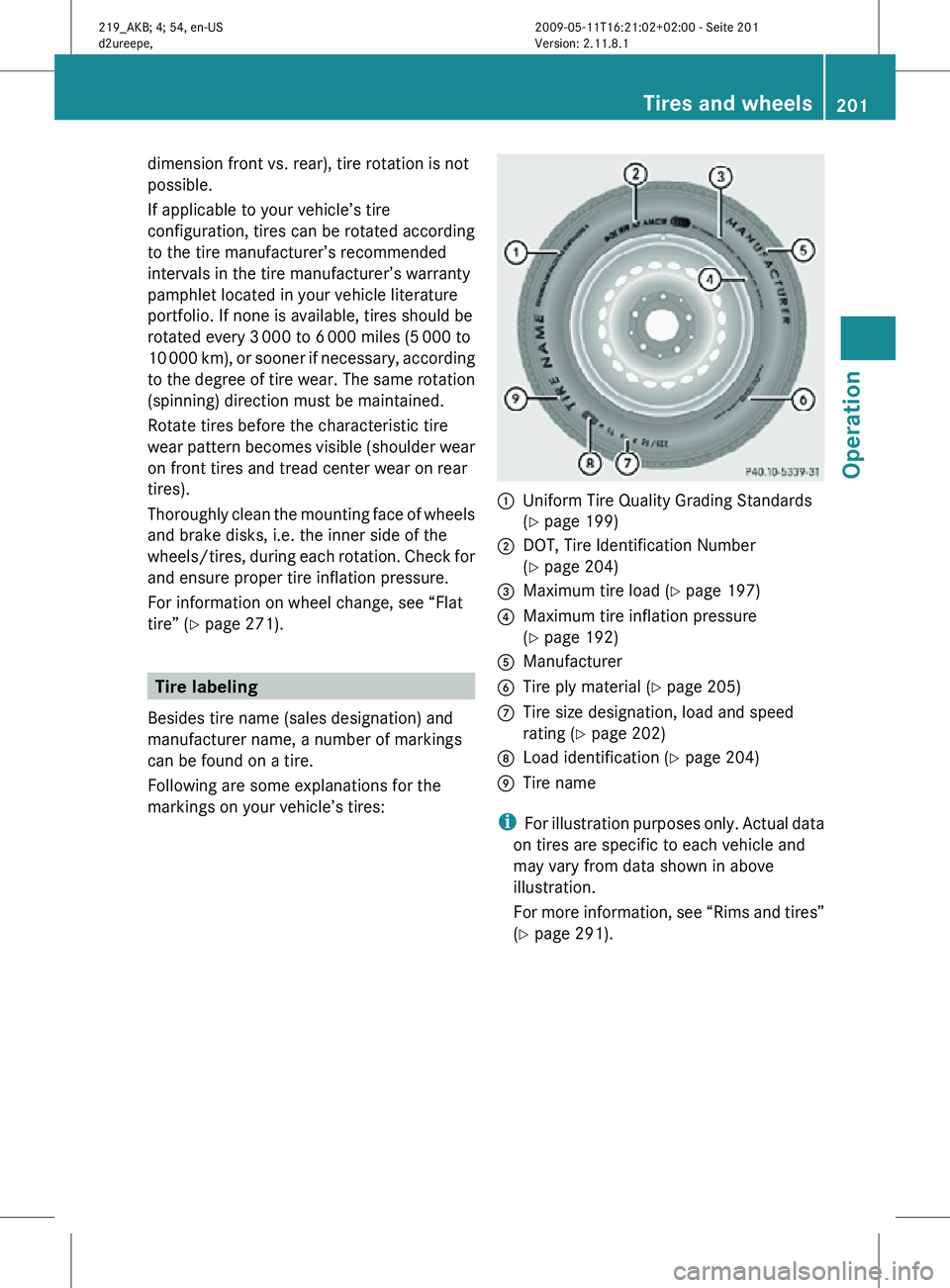
dimension front vs. rear), tire rotation is not
possible.
If applicable to your vehicle’s tire
configuration, tires can be rotated according
to the tire manufacturer’s recommended
intervals in the tire manufacturer’s warranty
pamphlet located in your vehicle literature
portfolio. If none is available, tires should be
rotated every 3 000 to 6
000 miles (5 000 to
10 000 km), or sooner if necessary, according
to the degree of tire wear. The same rotation
(spinning) direction must be maintained.
Rotate tires before the characteristic tire
wear pattern becomes visible (shoulder wear
on front tires and tread center wear on rear
tires).
Thoroughly clean the mounting face of wheels
and brake disks, i.e. the inner side of the
wheels/tires, during each rotation. Check for
and ensure proper tire inflation pressure.
For information on wheel change, see “Flat
tire” ( Y page 271). Tire labeling
Besides tire name (sales designation) and
manufacturer name, a number of markings
can be found on a tire.
Following are some explanations for the
markings on your vehicle’s tires: :
Uniform Tire Quality Grading Standards
(Y page 199)
; DOT, Tire Identification Number
(Y page 204)
= Maximum tire load ( Y page 197)
? Maximum tire inflation pressure
(Y page 192)
A Manufacturer
B Tire ply material ( Y page 205)
C Tire size designation, load and speed
rating (Y page 202)
D Load identification ( Y page 204)
E Tire name
i For illustration purposes only. Actual data
on tires are specific to each vehicle and
may vary from data shown in above
illustration.
For more information, see “Rims and tires”
(Y page 291). Tires and wheels
201Operation
219_AKB; 4; 54, en-US
d2ureepe, Version: 2.11.8.1 2009-05-11T16:21:02+02:00 - Seite 201 Z